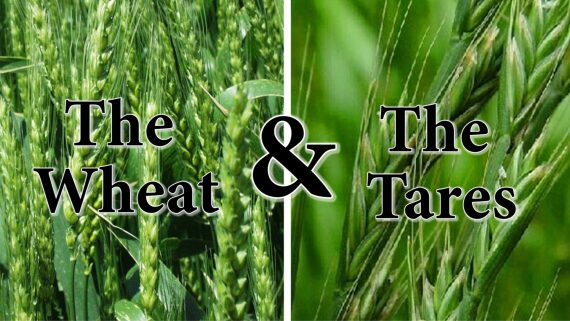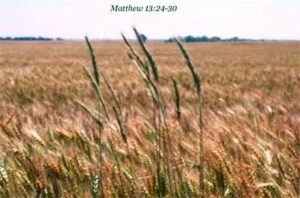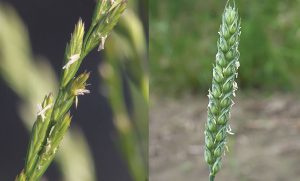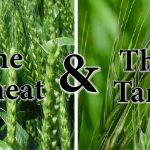In this podcast episode, we look at what to expect from a Biden/Harris administration, how to know you have not committed the unforgivable sin, and a parable from Jesus that speaks to both issues (The Parable of the Wheat and the Tares in Matthew 13:24-30).
Predictions for Biden/Harris Administration
I always find it interesting that when people who hate President Trump hear about his accomplishments, they say things like “Yeah, but he made a lewd comment about women fifteen years ago!” or “Yeah, but he called racists ‘very fine people’!”
These sorts of rebuttals are laughable. Take the “very fine people” comment. If you actually go look at what he said, Trump totally condemned the white supremacists and neo-Nazis in the Charlottesville crowd that day, but said that apart from them, there were other very fine people there. If these sorts of arguments are the best you have in saying that Trump was bad, you may want to check your heart.
 Here’s the truth about politics. When it comes to politics, it doesn’t matter what politicians say … it matters what they DO. Many politicians lie. They say what they think the voters want to hear, and then when they get into power, they do the opposite. So I don’t really care if you think Trump was mean on Twitter or wasn’t the most polished speaker. All that matters is what he actually DID. And the facts speak for themselves. Take just two areas. Trump was the most pro-life and pro-peace president we have ever had. He is the only president in modern history to not start a war, but in fact, work to end them. He is the only president who took actual steps to end the slaughter of innocent, unborn babies. And since Jesus Himself is pro-life and pro-peace, these two factors alone mean that Trump was leading the nation in Christlike directions.
Here’s the truth about politics. When it comes to politics, it doesn’t matter what politicians say … it matters what they DO. Many politicians lie. They say what they think the voters want to hear, and then when they get into power, they do the opposite. So I don’t really care if you think Trump was mean on Twitter or wasn’t the most polished speaker. All that matters is what he actually DID. And the facts speak for themselves. Take just two areas. Trump was the most pro-life and pro-peace president we have ever had. He is the only president in modern history to not start a war, but in fact, work to end them. He is the only president who took actual steps to end the slaughter of innocent, unborn babies. And since Jesus Himself is pro-life and pro-peace, these two factors alone mean that Trump was leading the nation in Christlike directions.
And there are many other areas in which Trump did this as well. We have a verifiable and documented list of all the Trump Administration Accomplishments, most of which are the exact opposite of all the doom and gloom predictions that people made about a Trump presidency. They predicted he was going to get us into another war. Instead, he got us out of wars, brought our troops home, and helped bring peace to the Middle East, and eased tensions with N. Korea. I heard some people predict that he would round up and arrest gays and lesbians, which is simply absurd. They predicted the stock market would crash. It saw record gains.
 Anyway, since people made predictions about the Trump presidency when it began, let me make a few predictions of my own for what will occur under a Biden/Harris Administration. I will revisit this list prior to the next presidential election to see how I did.
Anyway, since people made predictions about the Trump presidency when it began, let me make a few predictions of my own for what will occur under a Biden/Harris Administration. I will revisit this list prior to the next presidential election to see how I did.
- Biden won’t make it through the year. Probably not even 6 months. He is in serious cognitive decline. He will resign for medical reasons, allowing Harris to step in.
- When Trump became President, he left many Obama-era appointees in office, and they continually sought to undermine him and his presidency. Biden will not make the same mistake. He will remove from office as many Trump appointees as he can. Sadly, while the media would have blasted Trump for doing such a thing, they will praise Biden for such actions, thereby showing more of their hypocrisy. (1/21/21 update: Biden’s first firing was Jerome Adams, the Surgeon General)
- Under Biden and Harris, all of the economic gains achieved by Trump will disappear and be reversed. There will be widespread economic downturn.
- Tax increases for everyone
- Higher poverty and homeless rates
- Higher unemployment rates, especially for Blacks, Hispanics, and women (all made worse by a massive influx of immigrants) (1/21/21 update … job losses have already begun as tens of thousands of union workers have lost their jobs from the end of the Keystone Pipeline and a call to end all fracking, which, by the way, Biden promised during his campaign he would not do)
- Lower stock market
- This $15 minimum wage hike will be a disaster. It will lead to higher prices across the board for everything, and a loss of at least one million entry-level jobs.
- Higher gas, oil, and electricity prices since US will no longer be energy independent (1/21/21 update: has already begun with the end of the Keystone pipeline and the end of fracking)
- Higher prescription drug prices and healthcare costs as the Democrats seek to increase bureaucracy and decrease competition in the marketplace
- Lower household income for the middle class
- Under Biden and Harris, there will also be greater social problems in the US and around the world
- As we support terrorist nations with gas and oil purchases, they will fund more terrorist activity in the US and abroad
- Peace will be endangered in the middle east, and especially with Israel
- Tensions will rise with N. Korea, Iran, Iraq, and Afghanistan, many of which will seek to develop their nuclear weapon capabilities
- A declaration of war on at least one other country
- Less religious freedom in the US and around the world
- Less free speech for those who don’t agree with people in power (already begun as Google, Facebook, Twitter, Apple, and Instagram are actively censoring Trump supporters, and even Trump himself)
- Greater violence in our cities
- Higher incarceration rates for Blacks and Hispanics
- More drug overdoses
- Gun control will increase, and along with it, gun crimes. As statistics reveal in the US, where there is more control there is more gun crime.
- Higher crime rates in nearly every community
- An increase in abortions (1/21/21 update, A Biden EO has provided taxpayer funding for abortions)
- Women’s rights and protections will go backward (for example, with a push to legalize prostitution, and to allow transgender men to participate in women’s sports. 1/21/21 update: already occurring through EO on Gender Identity and Sexual Orientation)
- Trump and conservatives will be blamed by the democrats and by the media for all of the problems listed above
- One positive thing that will result from the Biden/Harris presidency is that COVID will disappear. They will do a mask mandate, and maybe a vaccination mandate, and then claim victory over COVID.
The Mail Bag
Numerous questions about the Unforgivable Sin and God’s love and forgiveness:
I bought (#AmazonAdLink) your book about the unforgiveable sin. I don’t find any part talking about jokes that includes the Holy Spirit. I laughed a joke like that and I was terrified I committed the unforgiveable sin. Do you think I committed it? – Hernyak
I sometimes have blasphemous thoughts and in a counseling session told the pastor the blasphemous thought the demons were trying to put in my head. It was against the Holy Spirit and was not from me so just telling the pastor what the thought was will not send me to hell will it? – Anonymous
I fear that I’ve committed the unpardonable sin because I said something really horrible to the Holy Spirit in my mind. Hoping that you can give me some shred of hope. It’s killing me and I constantly doubt my salvation. These doubts have plagued me for years. – Mike
If you fear that you have committed the sin, this proves you haven’t. Why? Because it proves that the Holy Spirit is still at work in you to draw you to Jesus and convict you of sin. Read my sermon on the unforgivable sin.
This is not to say it is healthy to fear this sin. It isn’t. We should be able to rest in the love and and forgiveness of God, knowing that when we come to understand both, we will not fear, for there is no fear in love (1 John 4:18).
How to know you are loved, forgiven, and have eternal life? Believe in Jesus for eternal life (John3 :16; 5;24; 6:47). Once you have eternal life, it is yours forever. You cannot lose it. Eternal life, by definition, is eternal.
The Parable of the Wheat and the Tares (Matthew 13:24-30)
In the Bible study section of this podcast, we are looking at a passage that applies to both of the two previous sections, the politics section and the mail bag section. When there are different perspectives, different viewpoints, or different ideas about theology or politics, how can we know which view is correct, and which view is wrong? This is a big issue, right? We all want to know the truth. We want to do what is correct. We want to follow Jesus properly and do what is best for our families, our country, and this world. But how can we know which is the best and most Christlike way of walking?
Jesus provides the answer in the Parable of the Wheat and the Tares (Matthew 13:24-30). This study is a summary of what I teach in my Gospel Dictionary online course, in the entries on Fire and the Kingdom of God.

In the Parable of the Wheat and the Tares, Jesus says that the kingdom of heaven is like a man who sows good seed in his field (Matthew 13:24). The kingdom of heaven, of course, is not heaven, but is the way God brings heaven down to earth as Jesus and His disciples spread the rule and reign of God over the earth. It begins with the sower spreading seed. But an enemy comes and sows bad seeds in the field, so that a bunch of weeds, or tares, spring up among the wheat.
The seed that Jesus refers to should be read in light of the first parable of Matthew 13, the Parable of the Four Soils. There, Jesus teaches that the seed is the Word of God. But here in Matthew 13 we see that there are two types of seeds that can be scattered. There are the seeds of kingdom, and the seeds of the devil. These are two contrasting kingdoms, which result in two contrasting types of people. But initially, when the seeds first begin to sprout, there is great difficulty in deciding between the wheat and weeds.
When the servants discover the weeds, they ask how the weeds came to exist and what the owner wants to do about them (Matthew 13:25-27). This is where some humor enters into this parable. As anyone who has ever had a field (or even a flower garden) knows, one does not need an enemy to sow bad seeds for weeds to pop up and grow. So when Jesus describes an enemy sowing bad seeds in the owner’s field, His audience would have likely snickered a little bit. No enemy would work so hard to ruin a crop. If an enemy really wanted to ruin someone’s crop, there were better and easier ways to do it. But the enemy does sow bad seeds in this story, which not only shows his own foolishness, but also provides a humorous backdrop for the rest of the story.
Many commentaries and articles point out that the bad seed in the field is most likely darnel, which looks exactly like wheat until harvest time. It is a mimic weed. This is why the owner of the field tells his servants to just let the two plants grow side by side until harvest (Matthew 13:27-30). Prior to harvest, it would be nearly impossible to tell the two apart, and so any attempt to remove the darnel would likely result in the loss of wheat as well. Once harvest arrives, wheat turns golden and the heavy heads of grain droop down toward the ground, but darnel tends to remain greener for longer and will continue to stand upright.
 Since wheat and darnel appear so identical, the presence of the tares in the field goes unnoticed until the grain begins to “go to crop,” or develop a head. This is why the servants only notice the tares once the wheat begins to mature (Matthew 13:26). So they ask the owner if he wants them to pull out the tares, but since wheat and darnel look quite similar to each other prior to full maturity, the owner tells his servants to leave the weeds alone and let them grow along with the wheat. At harvest, the reapers will go through and gather the tares, and then they can harvest the wheat (Matthew 13:30). The tares are thrown into the fire to be burned.
Since wheat and darnel appear so identical, the presence of the tares in the field goes unnoticed until the grain begins to “go to crop,” or develop a head. This is why the servants only notice the tares once the wheat begins to mature (Matthew 13:26). So they ask the owner if he wants them to pull out the tares, but since wheat and darnel look quite similar to each other prior to full maturity, the owner tells his servants to leave the weeds alone and let them grow along with the wheat. At harvest, the reapers will go through and gather the tares, and then they can harvest the wheat (Matthew 13:30). The tares are thrown into the fire to be burned.
One of the reasons it was necessary to first harvest and then burn the tares is because darnel can be deadly to livestock and humans if consumed in large quantities. Smaller quantities will cause dizziness if baked into bread or brewed with beer. In fact, there are historical records of people actually cultivating darnel for this very reason, treating it like an ancient form of cannabis. But if too much is consumed, darnel can cause great sickness and even death.
When Jesus explains this parable to His disciples, He begins by identifying the various characters in the story. He says that the sower is the Son of Man (Matthew 13:37), which is one of Jesus’s favorite titles for Himself. The field which the sower plants is the world, and so the good seeds which go out into the world are the sons of the kingdom (Matthew 13:38). The tares are therefore the opposite of the sons of the kingdom; Jesus calls them the sons of the wicked one. The enemy is the devil, the harvest is the end of the age, and the reapers are the angels (Matthew 13:38).
Now each of these characters need to be more carefully explained, but first, it is critical to notice that there is one set of characters Jesus does not identify. This missing identification is the key to the parable. Who is it that Jesus does not identify? It is the servants. Jesus does not explain who the servants represent. I have heard some say that the servants are the reapers, but when the owner is speaking to the servants, he clearly identifies the reapers as a different group (cf. Matthew 13:30).
The solution to this problem is to return to the image of the field as the world. The Son of Man sowed seeds in the field, and the servants went out and worked in the field. Since the field is the world, and Jesus is the one who sowed the seeds in the world, then the servants are the ones who tend, cultivate, and work in the fields. Who are they? They are the followers of Jesus. They are disciples. The servants in the story are the Christians. Christians, or followers of Jesus, are those who work in the world to grow and expand the kingdom of God which Jesus planted and initiated.
 But if the servants are Christians, then who are the “sons of the kingdom”? Jesus says the seed is the sons of the kingdom. But if the servants are Christians, then the sons of the kingdom (the seed) cannot also be Christians. To put it another way, since the servants are the followers of Jesus, then this means that the sons of the kingdom must be someone else. And when we understand the identity of the sons of the kingdom, we will also understand the identity of the sons of the evil one (which might be better translated as “sons of wickedness”; Matthew 13:38).
But if the servants are Christians, then who are the “sons of the kingdom”? Jesus says the seed is the sons of the kingdom. But if the servants are Christians, then the sons of the kingdom (the seed) cannot also be Christians. To put it another way, since the servants are the followers of Jesus, then this means that the sons of the kingdom must be someone else. And when we understand the identity of the sons of the kingdom, we will also understand the identity of the sons of the evil one (which might be better translated as “sons of wickedness”; Matthew 13:38).
To understand the identity of both, it is first necessary to understand how the word “son” is used in Scripture. Typically, a “son” is understood to be a child of someone else. But the word “son” can also be used metaphorically. When the word “son” is used in connection to a concept or idea, instead of to a person or family, it refers to the characteristics or inner attributes of someone, rather than to the person themselves. So “sons of this world” are contrasted with “sons of light” in Luke 16:8 (cf. John 12:36; 1 Thess 5:5). A student or disciple of the Pharisees could be called a “son of the Pharisees” (Matt 12:27; Acts 23:6). Scripture can also speak of “sons of the resurrection” (Luke 20:36), “sons of this age” (Luke 16:8; 20:34), “sons of disobedience” (Eph 2:2; 5:6), “sons of the devil” (Acts 13:10) and numerous other similar terms. Such descriptions are not literal (a son of the devil is not literally the biological offspring of the devil), but are instead figurative and symbolic ways of referring to someone’s character and behavior.
So who are the sons of the kingdom and the sons of wickedness, and how can we tell?
One more contextual key is needed before an answer is discovered. In the context before these seven parables of Matthew 13, the Jewish religious leaders accused Jesus of operating according to the power of Beelzebub (Matthew 12:24). Jesus responds with a teaching full of symbolism and imagery (Matthew 12:25-37) that shows up again in the parables of Matthew 13. He speaks of kingdoms (Matthew 12:25, 28), sons of the Pharisees (Matthew 12:27), gathering and scattering (Matthew 12:30), this age and the age to come (Matthew 12:32), and the fruitfulness (or lack thereof) of various trees (Matthew 12:33-37). All the parables of Matthew 13 must be read in light of this confrontation between Jesus and the Pharisees. While they were accusing Him of doing the devil’s work, He responded by saying that it was not Him, but they, who were committing blasphemy and speaking evil from their hearts (Matthew 12:35).
But how could the onlookers, the disciples, tell who was right? They had grown up being taught to love, respect, and listen to the religious Pharisees. But now they loved, respected, and listened to Jesus. Yet the Pharisees were saying that the teachings of Jesus were from the devil, and now Jesus was saying the same thing about the teachings of the Pharisees. So what were the disciples to do? How could they know who was right and who was wrong? If you have ever had two Bible teachers, both of whom you greatly respect, disagree with each other, then you understand the dilemma of the disciples. How were they to choose between Jesus and the Pharisees?
The Parable of the Wheat and the Tares is the answer to their question. In this parable, Jesus, the Son of Man, tells His servants, the disciples, that two types of seeds have been sown which result in two types of sons of two types of kingdoms. But which was which and how could they know? Jesus tells His disciples to wait until the harvest “at the end of this age” (Matthew 13:40). But this is not helpful for them if the end of the age is thousands of years in the future when the new heavens and new earth are created.
So what if “this age” was the age in which Jesus and His disciples were living, and the age to come was the age that followed (cf. Matthew 12:32)? Indeed, Scripture indicates in numerous ways and places that a new age did indeed come into existence with the death and resurrection of Jesus and the birth of the church. The death and resurrection of Jesus gave birth to a new age, the age of the kingdom of God, the church age. There were birth pains and many travails as the old age died and the new age began (as Jesus discusses in Matthew 24–25), but the resurrection of Jesus and the birth of the church was the sign that the new age had begun.
Jesus tells His disciples that while it is difficult for them to decide between the wheat and the tares right now, it will become clear to them at the harvest. Though they had trouble deciding between the way of Jesus and the way of the Pharisees, the end of the age would make it clear when the messengers of God arrived and took away the tares. Here we have the religiously subversive nature of the parable. The disciples of Jesus are faced with a choice: they can either follow the way of Jesus or the way of the Pharisees. Jesus tells them that they don’t need to figure it out. In fact, it would be dangerous for them to try to do so, for they will not be able to properly and perfectly tell the difference between the good teaching and bad. Instead, they should just wait for the harvest and let the reaping angels separate the wheat from the chaff.
And this is indeed what happened in 70 AD. The way of the Pharisees was destroyed when Jerusalem and the temple were burned with fire. This does not mean that the Pharisees and all who followed their teachings were unregenerate sinners who will spend eternity burning in hell. Everlasting torture in hell is not anywhere in view with this parable. To the contrary, the “furnace of fire” imagery is drawn from Daniel 3:19-25 where Daniel’s friends are thrown into a furnace of fire, but only their bonds are burned as they walk around in the flame with one shining like the Son of God. (As a side note, the “Son of Man” imagery is drawn from Daniel 7:13-14, and the imagery of the righteous shining like the sun in Matthew 13:43 is drawn from Daniel 12:3). It can be assumed that when Jerusalem was destroyed by the Roman army, many Christians were also consumed by the flames. But Christianity survived, as it was not (and is not) dependent upon a city, a temple, or a priesthood. Yet the Jewish Pharisaical religion was dependent upon such things, and so it died out when Jerusalem fell.
And so we see that the burning of the chaff in the furnace of fire is not about God sending people to hell where they will burn forever and ever. Instead, it is about the disciples of Jesus allowing God to be the one to judge between right and wrong, good and evil, especially when it comes to deciding between the teachings of Jesus and the teachings of the Pharisees. As a result of the events in Genesis 3 when Adam and Eve tried to gain for themselves what should be left up to God, we humans have always done a poor job of judging between good and evil. So God invites us to leave all such judgment up to Him. And this is what Jesus tells His disciples to do as well.
The same truth applies to us today. Humans make bad judgments, and when we do, we stumble and get burned. But this does not mean we go to hell; it means we face the consequences of our poor decisions. While such consequences are painful, we need not worry too much about them, for they do not say anything about our eternal destinies, and indeed, only serve to purify us so that we shine like the sun in the kingdom of the Father (Matthew 13:43).

The principle of this parable still applies to us today. It is sometimes very difficult to tell the difference between good teaching and bad teaching. Or even between good and bad politics. When this occurs, the advice of Jesus is that we withhold judgment and wait for the harvest to come, when the choice will be obvious. The harvest occurs when the natural results or logical outcomes of the various teachings begin to bear fruit. When a teaching results in the fruit of the kingdom of heaven (which Paul calls the fruit of the Spirit in Galatians 5:22-23), then we can know that such teachings are good and godly. But when a teaching bears fruit that is worldly and of the devil (the works of the flesh in Galatians 5:19-21), such teachings can be safely rejected.
We cannot look to a person’s works to see whether or not they have eternal life, but we can (and should) look to a person’s works to see whether or not their teachings can be followed. As we do this, we can see whether or not the kingdom of heaven is truly taking root in their life, and therefore in ours as well if we follow their teachings and example.



